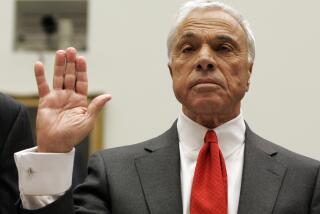Great American Chief Collapses; Vote Favors Sale
SAN DIEGO — Great American Bank Chairman Robert Kemper collapsed Thursday during a special shareholders meeting to approve the sale of the troubled savings and loan’s California branches to Wells Fargo Bank.
Kemper was admitted to Sharp Memorial Hospital and was undergoing tests late Thursday, at which time Great American said it had still not been given a diagnosis of his condition by doctors. Great American spokesman Brian Luscomb said the bank does not know how long Kemper would remain in the hospital, which described Kemper’s condition as good.
Kemper, 61, was answering questions from shareholders about 10:25 a.m. when he stopped in mid-sentence, pitched forward, then slumped to the Symphony Hall stage, grabbing a nearby table to break his fall. The 500 shareholders in attendance looked on in stunned silence until several began calling out for an ambulance.
Kemper quickly regained consciousness and was taken from Symphony Hall in San Diego to Sharp emergency room. Kemper, who was perspiring heavily before his collapse, told John McQueeney, a bank security official who rushed to Kemper’s side, that he was under treatment for high blood pressure.
Kemper told those surrounding him that he wanted to remain at the meeting but was persuaded by paramedics to go the hospital. He stood up from the stage floor on his own power and seated himself on the ambulance gurney. Asked by a reporter how he felt as he was being wheeled from Symphony Hall to an awaiting ambulance, Kemper smiled and said, “Fine.” Kemper told others that he felt no chest pains.
The meeting continued after Kemper’s departure, with 94% of Great American Bank votes cast in favor of the $492-million sale that was announced in July. The branch sale was the only alternative to a government takeover of the ailing thrift, said Marc Sandstrom, a senior executive vice president who led the meeting after Kemper’s departure.
The sale of the branches, which would give Wells Fargo the dominant depository market share in San Diego County, is still subject to approval by federal regulatory agencies, including the Office of Thrift Supervision.
However, Great American executives say they expect the first phase of the sale involving San Diego, Orange and Riverside county branches to be approved and completed by Nov. 30. The second phase, involving the rest of its statewide branches, should be complete by mid-1991.
Once complete, the sale will leave Great American with 81 branches in Arizona, Washington and Colorado, and mortgage banking operations in California. Terms of the deal prohibit Great American from opening retail branches or from collecting deposits in California.
At the meeting’s close, Great American announced the resignations of Jim Schmidt and Roger Lindland as board directors and that former chairman Gordon Luce and Sandstrom will also soon resign from the board.
Luce, Lindland and Schmidt had previously resigned or announced plans to resign from their executive positions at Great American. On Thursday, Sandstrom said he expects to leave his executive post next month.
Sandstrom said in an interview that Great American had regained more than half of the $1 billion in deposit run-offs that the thrift had lost earlier this year as its financial problems deepened. Total deposits, which by May had fallen to $8.1 billion from $9.1 billion at the end of 1989, have since rebounded to about $8.6 billion.
The $492-million sale price is subject to certain contingencies, but Sandstrom said that Great American would receive the full amount if the deal were to close now.
A former Wells Fargo vice chairman, Kemper assumed the reins of Great American in July and has since worked to put together a business plan to save the severely capital deficient thrift from a government seizure. The bank is awaiting approval of its new business plan by the Office of Thrift Supervision and other regulatory agencies.
Great American is deficient in all three capital tests applied by regulators to measure a financial institution’s strength. Kemper has said the proceeds from the sale of branches to Wells Fargo, combined with assets sales and cost reductions, will give the S&L; a chance of becoming a “viable institution.”
During his tenure, Kemper has made some difficult decisions as the S&L; has struggled to cut costs through layoffs and by selling assets. The bank has cut more than 122 jobs in California, most of them in its administrative staff. Wells Fargo will inherit the 1,900 employees at the 130 branches it is to acquire.
At Thursday’s meeting, Kemper answered a number of irate shareholders, including several who questioned whether Great American was getting its money’s worth from Wells Fargo and one who suggested that Great American executives take the “Lee Iacocca approach” and $1-per-year salaries until the S&L; regains its financial footing.
More to Read
Inside the business of entertainment
The Wide Shot brings you news, analysis and insights on everything from streaming wars to production — and what it all means for the future.
You may occasionally receive promotional content from the Los Angeles Times.








